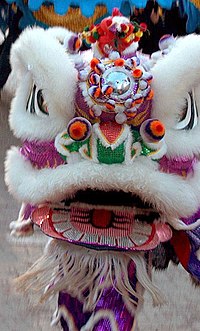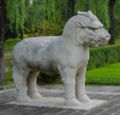Nian

In Chinese mythology, a Nian (simplified Chinese: 年兽; traditional Chinese: 年獸; pinyin: nián shòu) is a beast that lives under the sea or in the mountains. Once each spring, on or around Chinese New Year, it comes out of hiding to attack people, especially children. The Nian is sensitive to loud noises and is afraid of the color red. The Chinese Lion Dance is known to have originated from the legend of the Nian. The tradition began when a Nian attacked a village. After the attack, the villagers discussed how to make the Nian leave them alone. Eventually they came up with a plan where drums, plates and empty bowls were hit and firecrackers were thrown, causing loud banging sounds that would scare off the Nian. This scared the Nian, and since that time, the Nian has not appeared in the village again. The Nian is still believed to exist, but that it is scattered about the jungle and mountains, never to appear in front of a human again.
Traditions
The Chinese New Year traditions of decorating in red, exploding firecrackers, and performing a lion dance were originally used to scare the beast away. Some people display Chinese couplets on red banners to prevent the Nian from returning. Numerous other traditions such as wearing red clothing or handing out red envelopes are also designed to protect against the Nian.
The Chinese word for 'year' is the same as the name of this beast. A phrase for celebrating Chinese New Year, guo nian (simplified Chinese: 过年; traditional Chinese: 過年; pinyin: guò nián) means 'the passing of the beast'.
In the Lion Dance
A lion dance is a traditional dance usually performed by martial artists or acrobats. One or more performers hold up a large costume beast with a distinctive head, and one or more human characters will dance around the beast. Although these dances are commonly called lion dances, the beast portrayed is often not a lion. In northern China, it may be a Rui Shi (simplified Chinese: 瑞狮; traditional Chinese: 瑞獅; pinyin: ruì shī) or Fu Dog. In the south of China, it may be a nian. The Cantonese lion dance is sometimes a reenactment of the legend of Bu Dai taming the Nian.
See also
- Imperial guardian lions (also known as a Fu Dogs), typically stationed at entrances to important places. Note that Nian (horned) and the guardian lion (hornless) are different creatures.
- Pixiu similar beast but with wings.
- Qilin combining elements of fish, lion, deer, and ox.
- Luduan another beast with a single horn.
Gallery
-
A southern style nian in the lion, unicorn, and ox style (Ming)
-
Northern style nian of the Ming dynasty, located at the Ming Dynasty Tombs Sacred Walk


